GS1 Australia: Enhancing Supply Chain Management Through Standards
VerifiedAdded on 2023/06/13
|22
|5541
|371
Report
AI Summary
This industry report provides an overview of GS1 (Global Standards 1) Australia, the country’s leading provider of standards for ensuring uniformity in the international marketplace, serving over 20 industry sectors and 17,000 member companies. It details the application of GS1 standards, including barcodes, electronic business messaging, data synchronization, and RFID. The report highlights GS1 identification standards such as GLN (Global Location Number), GTIN (Global Trade Item Number), and SSCC (Serial Shipping Container Code), alongside GS1 application identifiers and data carriers like EAN/UPC barcodes and EPC/RFID tags. Furthermore, it discusses the benefits of using the GS1 system in supply chain management, emphasizing improved forecast accuracy, enhanced supply chain visibility, and the elimination of the bullwhip effect through technology.

2017
Assessment 3 – Industry Report
Mikael Abbas
Mikael Abbas s4543281
Tejusv Chauphla s4559240
Waleed Ahmed s4541350
Abdullah Alanazi s4533652
Assessment 3 – Industry Report
Mikael Abbas
Mikael Abbas s4543281
Tejusv Chauphla s4559240
Waleed Ahmed s4541350
Abdullah Alanazi s4533652
Paraphrase This Document
Need a fresh take? Get an instant paraphrase of this document with our AI Paraphraser
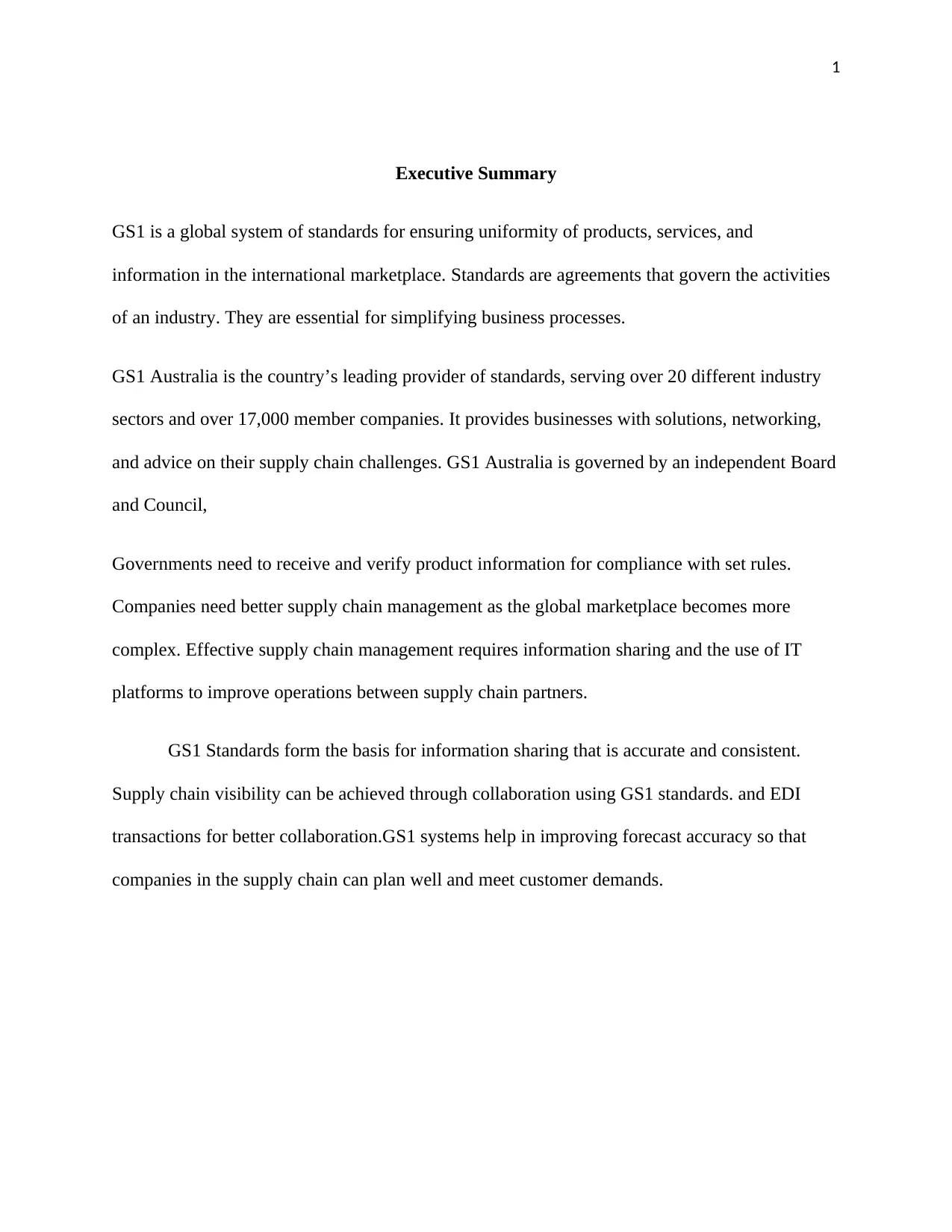
1
Executive Summary
GS1 is a global system of standards for ensuring uniformity of products, services, and
information in the international marketplace. Standards are agreements that govern the activities
of an industry. They are essential for simplifying business processes.
GS1 Australia is the country’s leading provider of standards, serving over 20 different industry
sectors and over 17,000 member companies. It provides businesses with solutions, networking,
and advice on their supply chain challenges. GS1 Australia is governed by an independent Board
and Council,
Governments need to receive and verify product information for compliance with set rules.
Companies need better supply chain management as the global marketplace becomes more
complex. Effective supply chain management requires information sharing and the use of IT
platforms to improve operations between supply chain partners.
GS1 Standards form the basis for information sharing that is accurate and consistent.
Supply chain visibility can be achieved through collaboration using GS1 standards. and EDI
transactions for better collaboration.GS1 systems help in improving forecast accuracy so that
companies in the supply chain can plan well and meet customer demands.
Executive Summary
GS1 is a global system of standards for ensuring uniformity of products, services, and
information in the international marketplace. Standards are agreements that govern the activities
of an industry. They are essential for simplifying business processes.
GS1 Australia is the country’s leading provider of standards, serving over 20 different industry
sectors and over 17,000 member companies. It provides businesses with solutions, networking,
and advice on their supply chain challenges. GS1 Australia is governed by an independent Board
and Council,
Governments need to receive and verify product information for compliance with set rules.
Companies need better supply chain management as the global marketplace becomes more
complex. Effective supply chain management requires information sharing and the use of IT
platforms to improve operations between supply chain partners.
GS1 Standards form the basis for information sharing that is accurate and consistent.
Supply chain visibility can be achieved through collaboration using GS1 standards. and EDI
transactions for better collaboration.GS1 systems help in improving forecast accuracy so that
companies in the supply chain can plan well and meet customer demands.
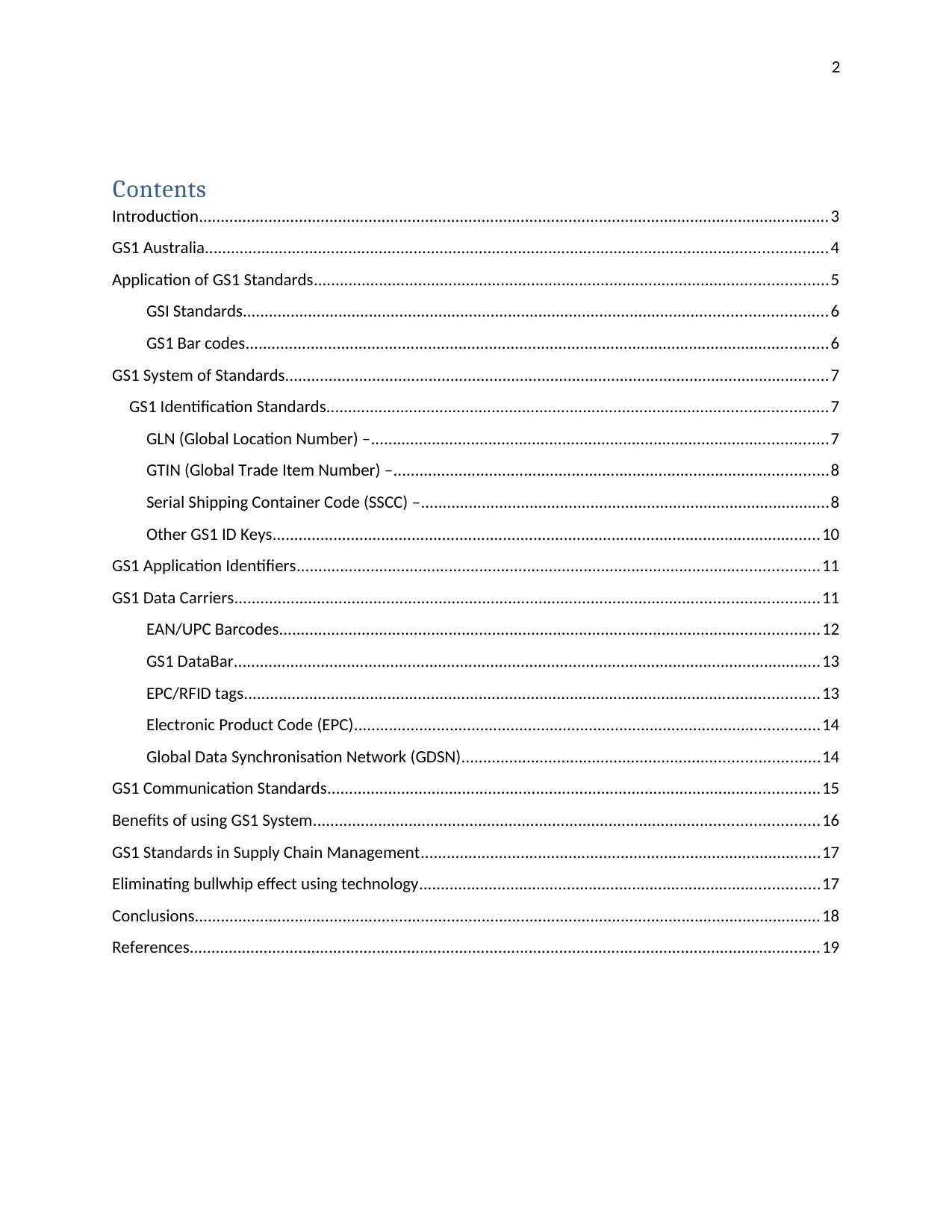
2
Contents
Introduction.................................................................................................................................................3
GS1 Australia...............................................................................................................................................4
Application of GS1 Standards......................................................................................................................5
GSI Standards......................................................................................................................................6
GS1 Bar codes......................................................................................................................................6
GS1 System of Standards.............................................................................................................................7
GS1 Identification Standards...................................................................................................................7
GLN (Global Location Number) –.........................................................................................................7
GTIN (Global Trade Item Number) –....................................................................................................8
Serial Shipping Container Code (SSCC) –..............................................................................................8
Other GS1 ID Keys..............................................................................................................................10
GS1 Application Identifiers........................................................................................................................11
GS1 Data Carriers......................................................................................................................................11
EAN/UPC Barcodes............................................................................................................................12
GS1 DataBar.......................................................................................................................................13
EPC/RFID tags....................................................................................................................................13
Electronic Product Code (EPC)...........................................................................................................14
Global Data Synchronisation Network (GDSN)..................................................................................14
GS1 Communication Standards.................................................................................................................15
Benefits of using GS1 System....................................................................................................................16
GS1 Standards in Supply Chain Management............................................................................................17
Eliminating bullwhip effect using technology............................................................................................17
Conclusions................................................................................................................................................18
References.................................................................................................................................................19
Contents
Introduction.................................................................................................................................................3
GS1 Australia...............................................................................................................................................4
Application of GS1 Standards......................................................................................................................5
GSI Standards......................................................................................................................................6
GS1 Bar codes......................................................................................................................................6
GS1 System of Standards.............................................................................................................................7
GS1 Identification Standards...................................................................................................................7
GLN (Global Location Number) –.........................................................................................................7
GTIN (Global Trade Item Number) –....................................................................................................8
Serial Shipping Container Code (SSCC) –..............................................................................................8
Other GS1 ID Keys..............................................................................................................................10
GS1 Application Identifiers........................................................................................................................11
GS1 Data Carriers......................................................................................................................................11
EAN/UPC Barcodes............................................................................................................................12
GS1 DataBar.......................................................................................................................................13
EPC/RFID tags....................................................................................................................................13
Electronic Product Code (EPC)...........................................................................................................14
Global Data Synchronisation Network (GDSN)..................................................................................14
GS1 Communication Standards.................................................................................................................15
Benefits of using GS1 System....................................................................................................................16
GS1 Standards in Supply Chain Management............................................................................................17
Eliminating bullwhip effect using technology............................................................................................17
Conclusions................................................................................................................................................18
References.................................................................................................................................................19
⊘ This is a preview!⊘
Do you want full access?
Subscribe today to unlock all pages.

Trusted by 1+ million students worldwide

3
Paraphrase This Document
Need a fresh take? Get an instant paraphrase of this document with our AI Paraphraser
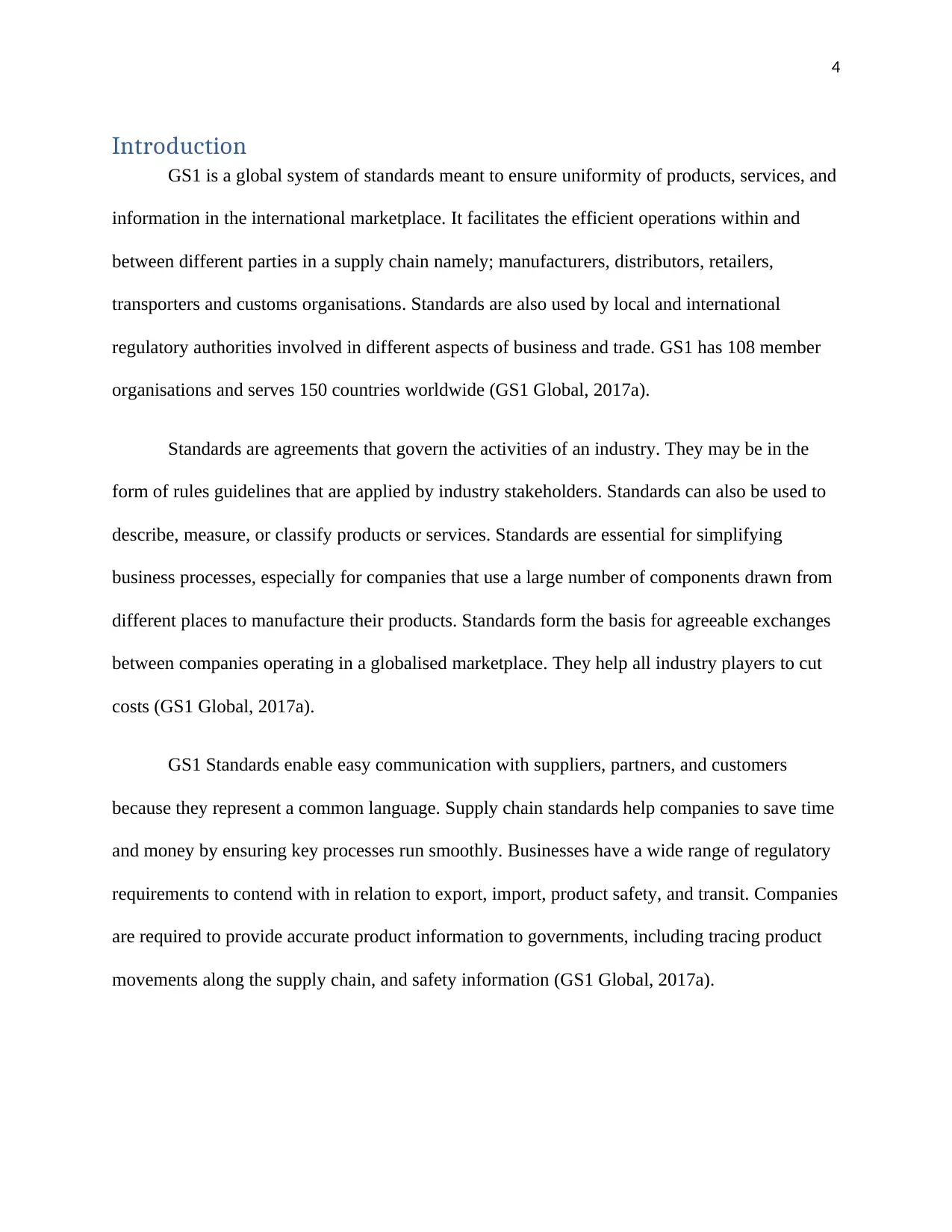
4
Introduction
GS1 is a global system of standards meant to ensure uniformity of products, services, and
information in the international marketplace. It facilitates the efficient operations within and
between different parties in a supply chain namely; manufacturers, distributors, retailers,
transporters and customs organisations. Standards are also used by local and international
regulatory authorities involved in different aspects of business and trade. GS1 has 108 member
organisations and serves 150 countries worldwide (GS1 Global, 2017a).
Standards are agreements that govern the activities of an industry. They may be in the
form of rules guidelines that are applied by industry stakeholders. Standards can also be used to
describe, measure, or classify products or services. Standards are essential for simplifying
business processes, especially for companies that use a large number of components drawn from
different places to manufacture their products. Standards form the basis for agreeable exchanges
between companies operating in a globalised marketplace. They help all industry players to cut
costs (GS1 Global, 2017a).
GS1 Standards enable easy communication with suppliers, partners, and customers
because they represent a common language. Supply chain standards help companies to save time
and money by ensuring key processes run smoothly. Businesses have a wide range of regulatory
requirements to contend with in relation to export, import, product safety, and transit. Companies
are required to provide accurate product information to governments, including tracing product
movements along the supply chain, and safety information (GS1 Global, 2017a).
Introduction
GS1 is a global system of standards meant to ensure uniformity of products, services, and
information in the international marketplace. It facilitates the efficient operations within and
between different parties in a supply chain namely; manufacturers, distributors, retailers,
transporters and customs organisations. Standards are also used by local and international
regulatory authorities involved in different aspects of business and trade. GS1 has 108 member
organisations and serves 150 countries worldwide (GS1 Global, 2017a).
Standards are agreements that govern the activities of an industry. They may be in the
form of rules guidelines that are applied by industry stakeholders. Standards can also be used to
describe, measure, or classify products or services. Standards are essential for simplifying
business processes, especially for companies that use a large number of components drawn from
different places to manufacture their products. Standards form the basis for agreeable exchanges
between companies operating in a globalised marketplace. They help all industry players to cut
costs (GS1 Global, 2017a).
GS1 Standards enable easy communication with suppliers, partners, and customers
because they represent a common language. Supply chain standards help companies to save time
and money by ensuring key processes run smoothly. Businesses have a wide range of regulatory
requirements to contend with in relation to export, import, product safety, and transit. Companies
are required to provide accurate product information to governments, including tracing product
movements along the supply chain, and safety information (GS1 Global, 2017a).
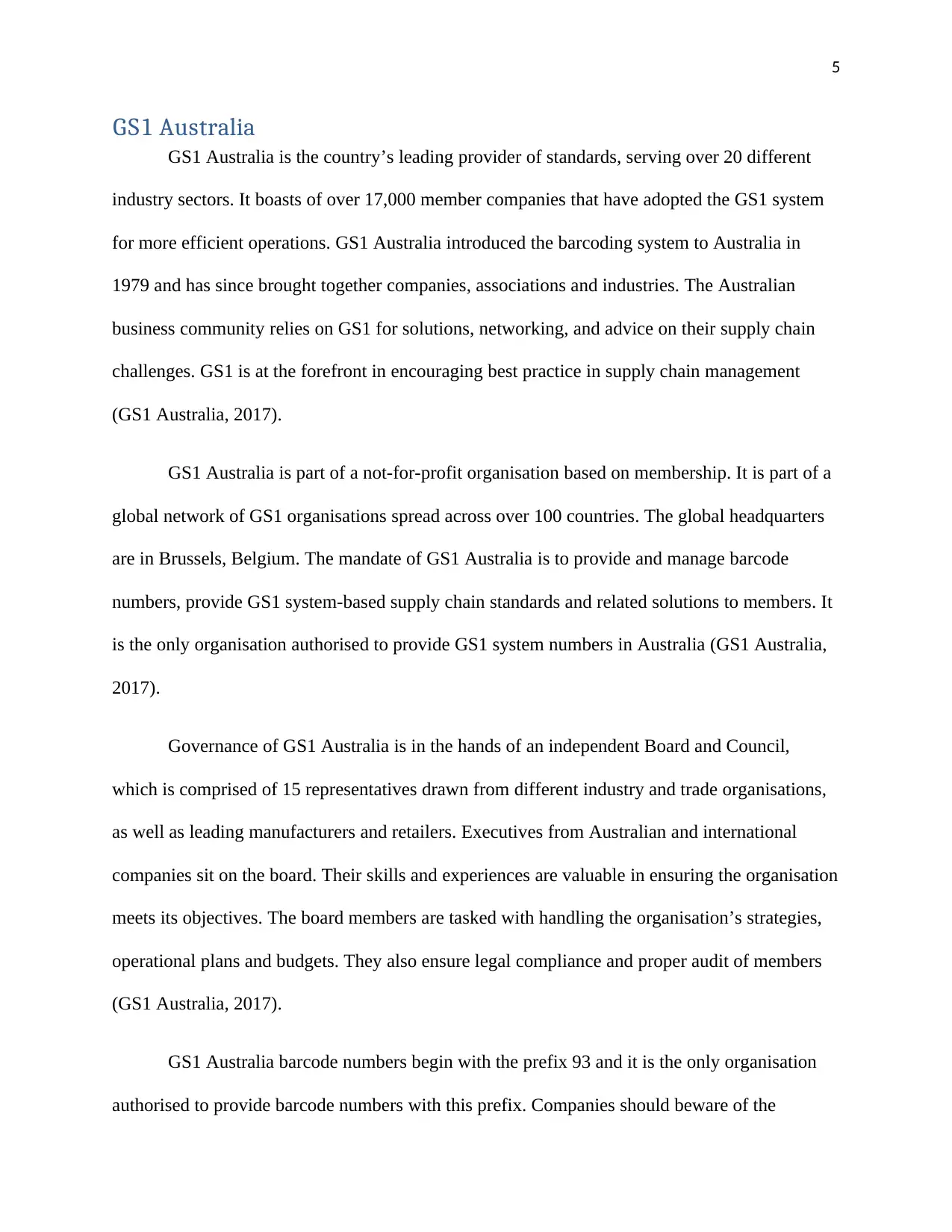
5
GS1 Australia
GS1 Australia is the country’s leading provider of standards, serving over 20 different
industry sectors. It boasts of over 17,000 member companies that have adopted the GS1 system
for more efficient operations. GS1 Australia introduced the barcoding system to Australia in
1979 and has since brought together companies, associations and industries. The Australian
business community relies on GS1 for solutions, networking, and advice on their supply chain
challenges. GS1 is at the forefront in encouraging best practice in supply chain management
(GS1 Australia, 2017).
GS1 Australia is part of a not-for-profit organisation based on membership. It is part of a
global network of GS1 organisations spread across over 100 countries. The global headquarters
are in Brussels, Belgium. The mandate of GS1 Australia is to provide and manage barcode
numbers, provide GS1 system-based supply chain standards and related solutions to members. It
is the only organisation authorised to provide GS1 system numbers in Australia (GS1 Australia,
2017).
Governance of GS1 Australia is in the hands of an independent Board and Council,
which is comprised of 15 representatives drawn from different industry and trade organisations,
as well as leading manufacturers and retailers. Executives from Australian and international
companies sit on the board. Their skills and experiences are valuable in ensuring the organisation
meets its objectives. The board members are tasked with handling the organisation’s strategies,
operational plans and budgets. They also ensure legal compliance and proper audit of members
(GS1 Australia, 2017).
GS1 Australia barcode numbers begin with the prefix 93 and it is the only organisation
authorised to provide barcode numbers with this prefix. Companies should beware of the
GS1 Australia
GS1 Australia is the country’s leading provider of standards, serving over 20 different
industry sectors. It boasts of over 17,000 member companies that have adopted the GS1 system
for more efficient operations. GS1 Australia introduced the barcoding system to Australia in
1979 and has since brought together companies, associations and industries. The Australian
business community relies on GS1 for solutions, networking, and advice on their supply chain
challenges. GS1 is at the forefront in encouraging best practice in supply chain management
(GS1 Australia, 2017).
GS1 Australia is part of a not-for-profit organisation based on membership. It is part of a
global network of GS1 organisations spread across over 100 countries. The global headquarters
are in Brussels, Belgium. The mandate of GS1 Australia is to provide and manage barcode
numbers, provide GS1 system-based supply chain standards and related solutions to members. It
is the only organisation authorised to provide GS1 system numbers in Australia (GS1 Australia,
2017).
Governance of GS1 Australia is in the hands of an independent Board and Council,
which is comprised of 15 representatives drawn from different industry and trade organisations,
as well as leading manufacturers and retailers. Executives from Australian and international
companies sit on the board. Their skills and experiences are valuable in ensuring the organisation
meets its objectives. The board members are tasked with handling the organisation’s strategies,
operational plans and budgets. They also ensure legal compliance and proper audit of members
(GS1 Australia, 2017).
GS1 Australia barcode numbers begin with the prefix 93 and it is the only organisation
authorised to provide barcode numbers with this prefix. Companies should beware of the
⊘ This is a preview!⊘
Do you want full access?
Subscribe today to unlock all pages.

Trusted by 1+ million students worldwide
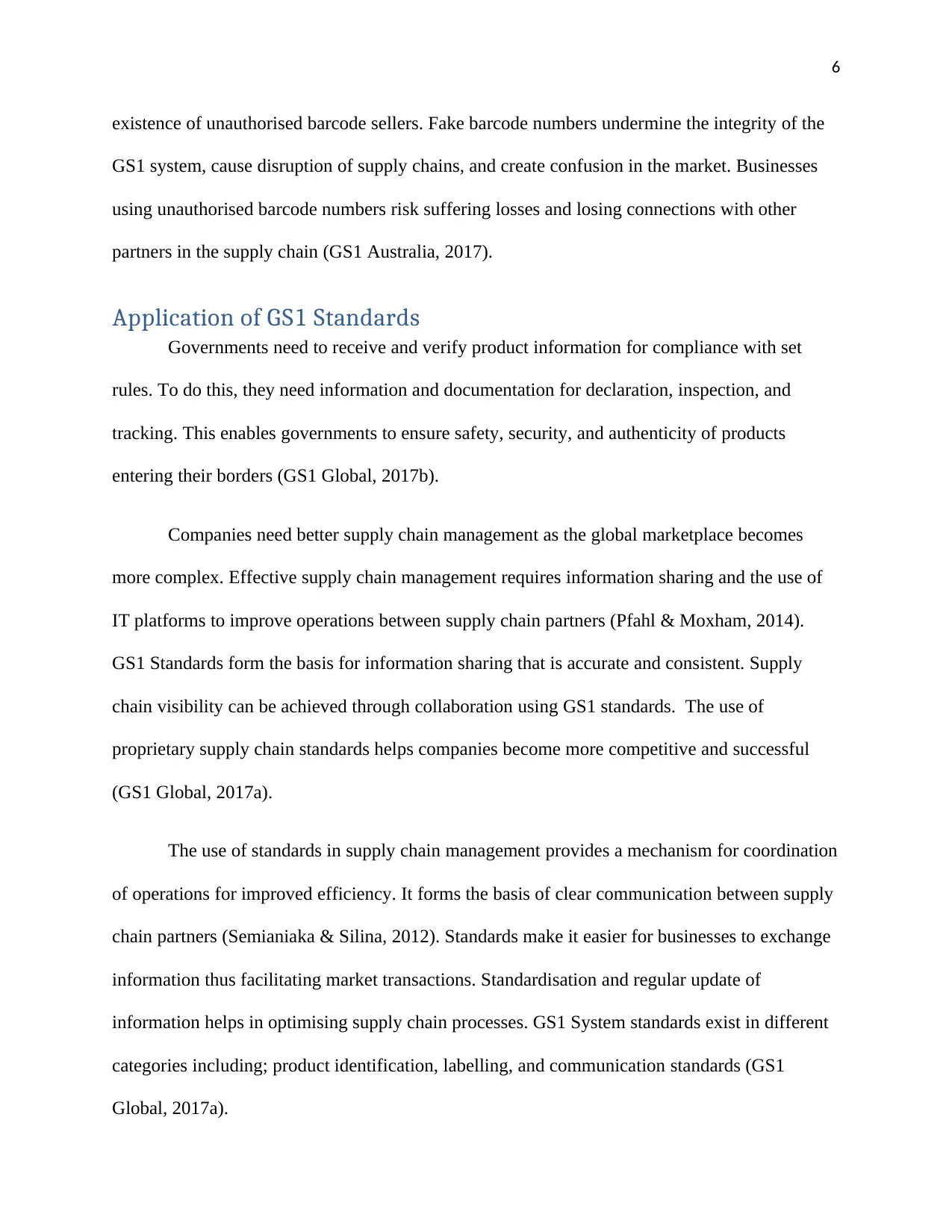
6
existence of unauthorised barcode sellers. Fake barcode numbers undermine the integrity of the
GS1 system, cause disruption of supply chains, and create confusion in the market. Businesses
using unauthorised barcode numbers risk suffering losses and losing connections with other
partners in the supply chain (GS1 Australia, 2017).
Application of GS1 Standards
Governments need to receive and verify product information for compliance with set
rules. To do this, they need information and documentation for declaration, inspection, and
tracking. This enables governments to ensure safety, security, and authenticity of products
entering their borders (GS1 Global, 2017b).
Companies need better supply chain management as the global marketplace becomes
more complex. Effective supply chain management requires information sharing and the use of
IT platforms to improve operations between supply chain partners (Pfahl & Moxham, 2014).
GS1 Standards form the basis for information sharing that is accurate and consistent. Supply
chain visibility can be achieved through collaboration using GS1 standards. The use of
proprietary supply chain standards helps companies become more competitive and successful
(GS1 Global, 2017a).
The use of standards in supply chain management provides a mechanism for coordination
of operations for improved efficiency. It forms the basis of clear communication between supply
chain partners (Semianiaka & Silina, 2012). Standards make it easier for businesses to exchange
information thus facilitating market transactions. Standardisation and regular update of
information helps in optimising supply chain processes. GS1 System standards exist in different
categories including; product identification, labelling, and communication standards (GS1
Global, 2017a).
existence of unauthorised barcode sellers. Fake barcode numbers undermine the integrity of the
GS1 system, cause disruption of supply chains, and create confusion in the market. Businesses
using unauthorised barcode numbers risk suffering losses and losing connections with other
partners in the supply chain (GS1 Australia, 2017).
Application of GS1 Standards
Governments need to receive and verify product information for compliance with set
rules. To do this, they need information and documentation for declaration, inspection, and
tracking. This enables governments to ensure safety, security, and authenticity of products
entering their borders (GS1 Global, 2017b).
Companies need better supply chain management as the global marketplace becomes
more complex. Effective supply chain management requires information sharing and the use of
IT platforms to improve operations between supply chain partners (Pfahl & Moxham, 2014).
GS1 Standards form the basis for information sharing that is accurate and consistent. Supply
chain visibility can be achieved through collaboration using GS1 standards. The use of
proprietary supply chain standards helps companies become more competitive and successful
(GS1 Global, 2017a).
The use of standards in supply chain management provides a mechanism for coordination
of operations for improved efficiency. It forms the basis of clear communication between supply
chain partners (Semianiaka & Silina, 2012). Standards make it easier for businesses to exchange
information thus facilitating market transactions. Standardisation and regular update of
information helps in optimising supply chain processes. GS1 System standards exist in different
categories including; product identification, labelling, and communication standards (GS1
Global, 2017a).
Paraphrase This Document
Need a fresh take? Get an instant paraphrase of this document with our AI Paraphraser
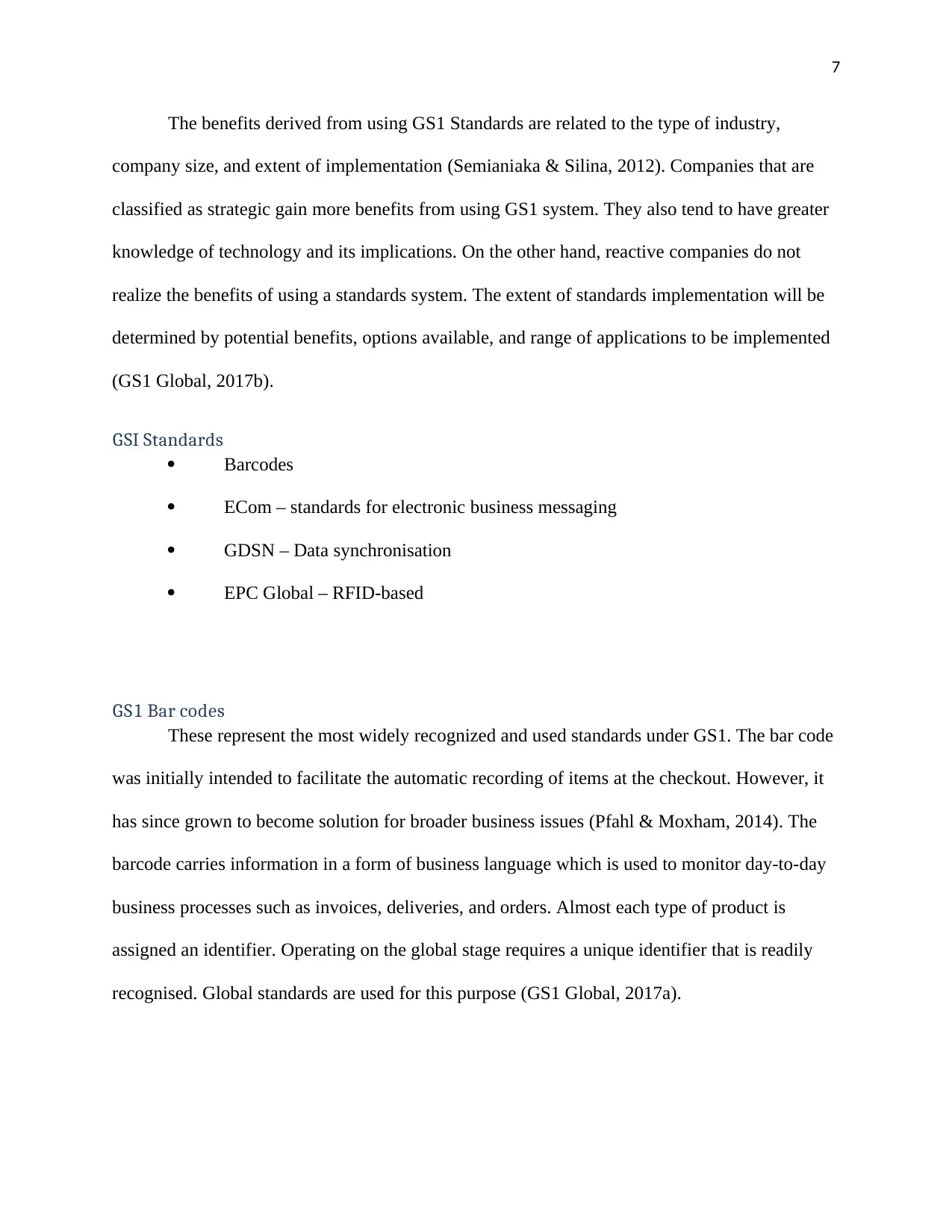
7
The benefits derived from using GS1 Standards are related to the type of industry,
company size, and extent of implementation (Semianiaka & Silina, 2012). Companies that are
classified as strategic gain more benefits from using GS1 system. They also tend to have greater
knowledge of technology and its implications. On the other hand, reactive companies do not
realize the benefits of using a standards system. The extent of standards implementation will be
determined by potential benefits, options available, and range of applications to be implemented
(GS1 Global, 2017b).
GSI Standards
Barcodes
ECom – standards for electronic business messaging
GDSN – Data synchronisation
EPC Global – RFID-based
GS1 Bar codes
These represent the most widely recognized and used standards under GS1. The bar code
was initially intended to facilitate the automatic recording of items at the checkout. However, it
has since grown to become solution for broader business issues (Pfahl & Moxham, 2014). The
barcode carries information in a form of business language which is used to monitor day-to-day
business processes such as invoices, deliveries, and orders. Almost each type of product is
assigned an identifier. Operating on the global stage requires a unique identifier that is readily
recognised. Global standards are used for this purpose (GS1 Global, 2017a).
The benefits derived from using GS1 Standards are related to the type of industry,
company size, and extent of implementation (Semianiaka & Silina, 2012). Companies that are
classified as strategic gain more benefits from using GS1 system. They also tend to have greater
knowledge of technology and its implications. On the other hand, reactive companies do not
realize the benefits of using a standards system. The extent of standards implementation will be
determined by potential benefits, options available, and range of applications to be implemented
(GS1 Global, 2017b).
GSI Standards
Barcodes
ECom – standards for electronic business messaging
GDSN – Data synchronisation
EPC Global – RFID-based
GS1 Bar codes
These represent the most widely recognized and used standards under GS1. The bar code
was initially intended to facilitate the automatic recording of items at the checkout. However, it
has since grown to become solution for broader business issues (Pfahl & Moxham, 2014). The
barcode carries information in a form of business language which is used to monitor day-to-day
business processes such as invoices, deliveries, and orders. Almost each type of product is
assigned an identifier. Operating on the global stage requires a unique identifier that is readily
recognised. Global standards are used for this purpose (GS1 Global, 2017a).
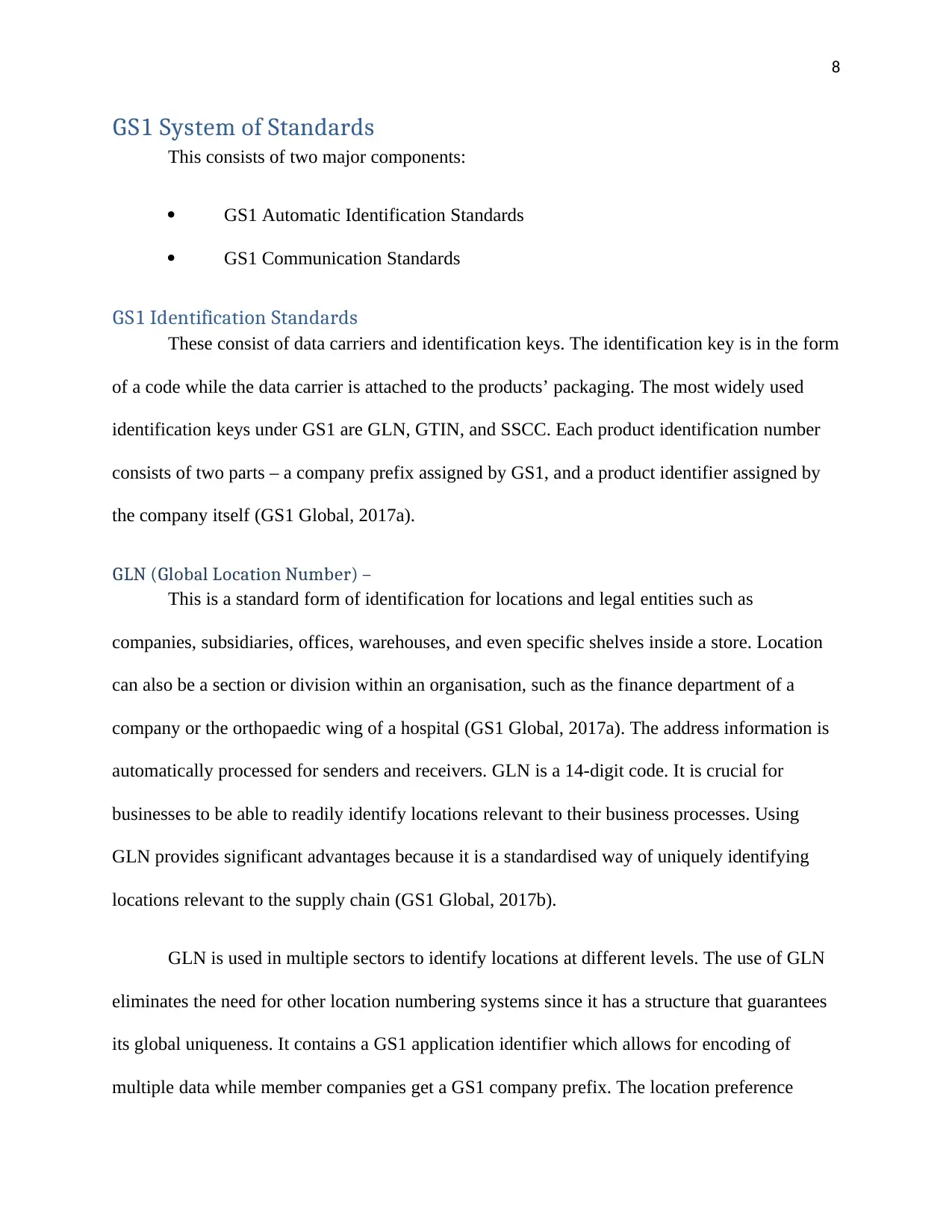
8
GS1 System of Standards
This consists of two major components:
GS1 Automatic Identification Standards
GS1 Communication Standards
GS1 Identification Standards
These consist of data carriers and identification keys. The identification key is in the form
of a code while the data carrier is attached to the products’ packaging. The most widely used
identification keys under GS1 are GLN, GTIN, and SSCC. Each product identification number
consists of two parts – a company prefix assigned by GS1, and a product identifier assigned by
the company itself (GS1 Global, 2017a).
GLN (Global Location Number) –
This is a standard form of identification for locations and legal entities such as
companies, subsidiaries, offices, warehouses, and even specific shelves inside a store. Location
can also be a section or division within an organisation, such as the finance department of a
company or the orthopaedic wing of a hospital (GS1 Global, 2017a). The address information is
automatically processed for senders and receivers. GLN is a 14-digit code. It is crucial for
businesses to be able to readily identify locations relevant to their business processes. Using
GLN provides significant advantages because it is a standardised way of uniquely identifying
locations relevant to the supply chain (GS1 Global, 2017b).
GLN is used in multiple sectors to identify locations at different levels. The use of GLN
eliminates the need for other location numbering systems since it has a structure that guarantees
its global uniqueness. It contains a GS1 application identifier which allows for encoding of
multiple data while member companies get a GS1 company prefix. The location preference
GS1 System of Standards
This consists of two major components:
GS1 Automatic Identification Standards
GS1 Communication Standards
GS1 Identification Standards
These consist of data carriers and identification keys. The identification key is in the form
of a code while the data carrier is attached to the products’ packaging. The most widely used
identification keys under GS1 are GLN, GTIN, and SSCC. Each product identification number
consists of two parts – a company prefix assigned by GS1, and a product identifier assigned by
the company itself (GS1 Global, 2017a).
GLN (Global Location Number) –
This is a standard form of identification for locations and legal entities such as
companies, subsidiaries, offices, warehouses, and even specific shelves inside a store. Location
can also be a section or division within an organisation, such as the finance department of a
company or the orthopaedic wing of a hospital (GS1 Global, 2017a). The address information is
automatically processed for senders and receivers. GLN is a 14-digit code. It is crucial for
businesses to be able to readily identify locations relevant to their business processes. Using
GLN provides significant advantages because it is a standardised way of uniquely identifying
locations relevant to the supply chain (GS1 Global, 2017b).
GLN is used in multiple sectors to identify locations at different levels. The use of GLN
eliminates the need for other location numbering systems since it has a structure that guarantees
its global uniqueness. It contains a GS1 application identifier which allows for encoding of
multiple data while member companies get a GS1 company prefix. The location preference
⊘ This is a preview!⊘
Do you want full access?
Subscribe today to unlock all pages.

Trusted by 1+ million students worldwide
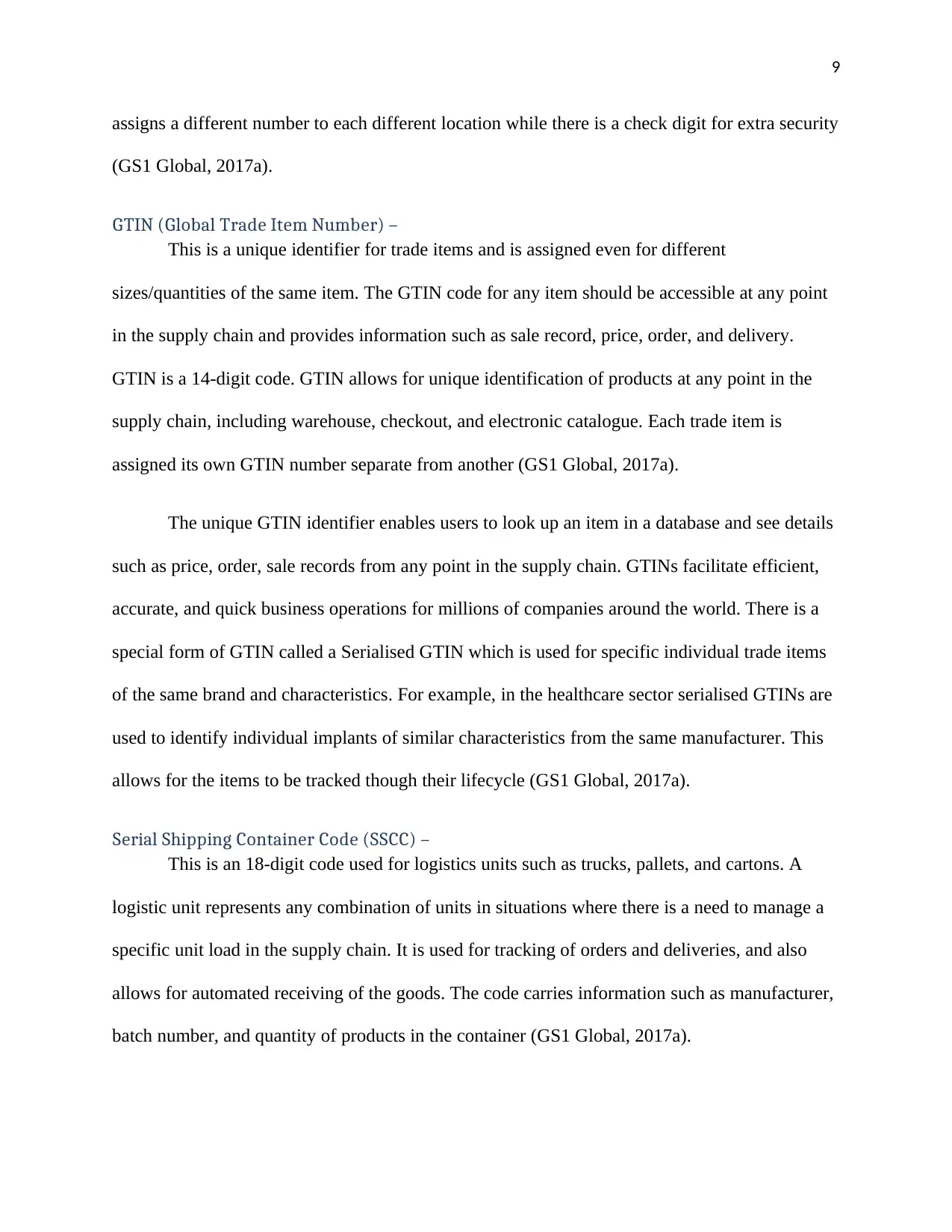
9
assigns a different number to each different location while there is a check digit for extra security
(GS1 Global, 2017a).
GTIN (Global Trade Item Number) –
This is a unique identifier for trade items and is assigned even for different
sizes/quantities of the same item. The GTIN code for any item should be accessible at any point
in the supply chain and provides information such as sale record, price, order, and delivery.
GTIN is a 14-digit code. GTIN allows for unique identification of products at any point in the
supply chain, including warehouse, checkout, and electronic catalogue. Each trade item is
assigned its own GTIN number separate from another (GS1 Global, 2017a).
The unique GTIN identifier enables users to look up an item in a database and see details
such as price, order, sale records from any point in the supply chain. GTINs facilitate efficient,
accurate, and quick business operations for millions of companies around the world. There is a
special form of GTIN called a Serialised GTIN which is used for specific individual trade items
of the same brand and characteristics. For example, in the healthcare sector serialised GTINs are
used to identify individual implants of similar characteristics from the same manufacturer. This
allows for the items to be tracked though their lifecycle (GS1 Global, 2017a).
Serial Shipping Container Code (SSCC) –
This is an 18-digit code used for logistics units such as trucks, pallets, and cartons. A
logistic unit represents any combination of units in situations where there is a need to manage a
specific unit load in the supply chain. It is used for tracking of orders and deliveries, and also
allows for automated receiving of the goods. The code carries information such as manufacturer,
batch number, and quantity of products in the container (GS1 Global, 2017a).
assigns a different number to each different location while there is a check digit for extra security
(GS1 Global, 2017a).
GTIN (Global Trade Item Number) –
This is a unique identifier for trade items and is assigned even for different
sizes/quantities of the same item. The GTIN code for any item should be accessible at any point
in the supply chain and provides information such as sale record, price, order, and delivery.
GTIN is a 14-digit code. GTIN allows for unique identification of products at any point in the
supply chain, including warehouse, checkout, and electronic catalogue. Each trade item is
assigned its own GTIN number separate from another (GS1 Global, 2017a).
The unique GTIN identifier enables users to look up an item in a database and see details
such as price, order, sale records from any point in the supply chain. GTINs facilitate efficient,
accurate, and quick business operations for millions of companies around the world. There is a
special form of GTIN called a Serialised GTIN which is used for specific individual trade items
of the same brand and characteristics. For example, in the healthcare sector serialised GTINs are
used to identify individual implants of similar characteristics from the same manufacturer. This
allows for the items to be tracked though their lifecycle (GS1 Global, 2017a).
Serial Shipping Container Code (SSCC) –
This is an 18-digit code used for logistics units such as trucks, pallets, and cartons. A
logistic unit represents any combination of units in situations where there is a need to manage a
specific unit load in the supply chain. It is used for tracking of orders and deliveries, and also
allows for automated receiving of the goods. The code carries information such as manufacturer,
batch number, and quantity of products in the container (GS1 Global, 2017a).
Paraphrase This Document
Need a fresh take? Get an instant paraphrase of this document with our AI Paraphraser
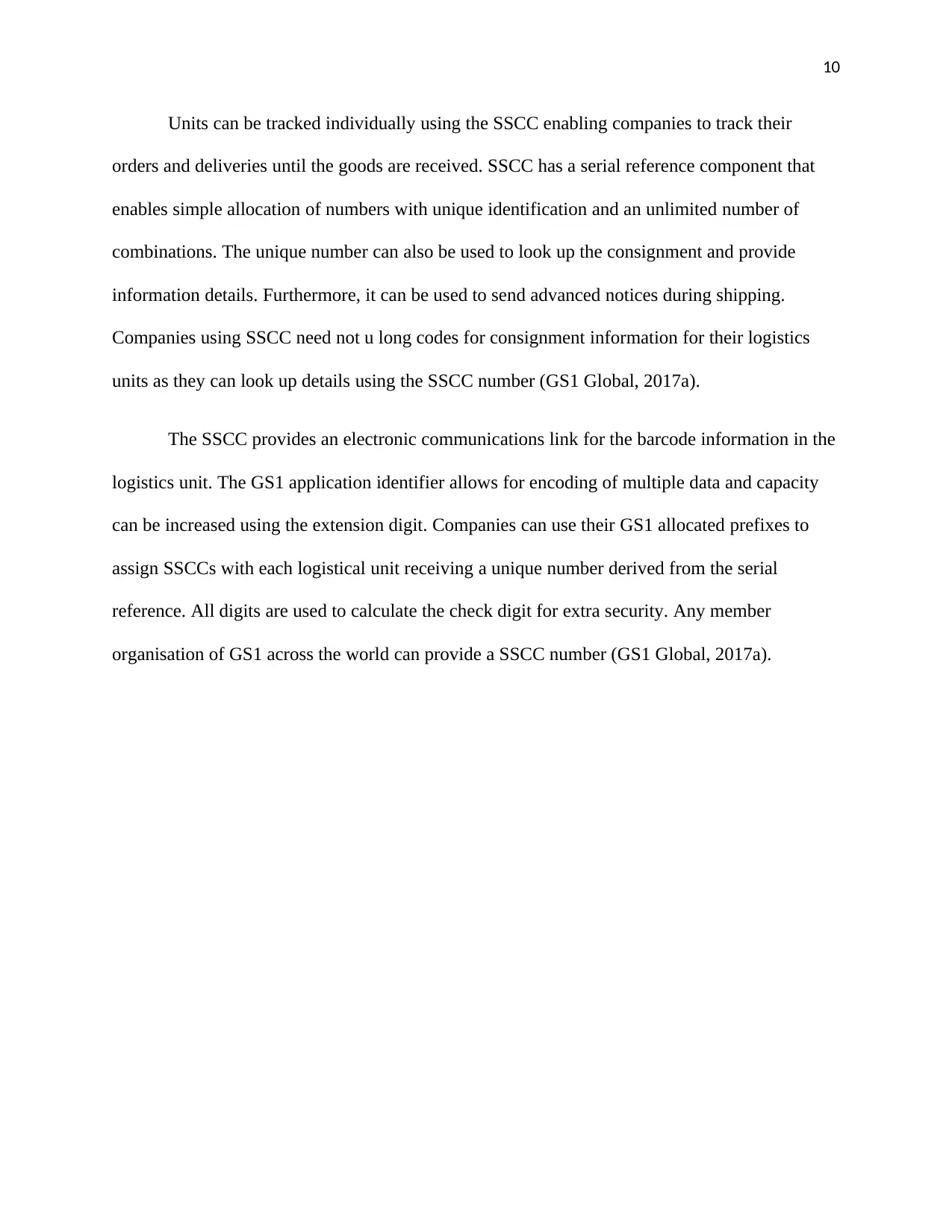
10
Units can be tracked individually using the SSCC enabling companies to track their
orders and deliveries until the goods are received. SSCC has a serial reference component that
enables simple allocation of numbers with unique identification and an unlimited number of
combinations. The unique number can also be used to look up the consignment and provide
information details. Furthermore, it can be used to send advanced notices during shipping.
Companies using SSCC need not u long codes for consignment information for their logistics
units as they can look up details using the SSCC number (GS1 Global, 2017a).
The SSCC provides an electronic communications link for the barcode information in the
logistics unit. The GS1 application identifier allows for encoding of multiple data and capacity
can be increased using the extension digit. Companies can use their GS1 allocated prefixes to
assign SSCCs with each logistical unit receiving a unique number derived from the serial
reference. All digits are used to calculate the check digit for extra security. Any member
organisation of GS1 across the world can provide a SSCC number (GS1 Global, 2017a).
Units can be tracked individually using the SSCC enabling companies to track their
orders and deliveries until the goods are received. SSCC has a serial reference component that
enables simple allocation of numbers with unique identification and an unlimited number of
combinations. The unique number can also be used to look up the consignment and provide
information details. Furthermore, it can be used to send advanced notices during shipping.
Companies using SSCC need not u long codes for consignment information for their logistics
units as they can look up details using the SSCC number (GS1 Global, 2017a).
The SSCC provides an electronic communications link for the barcode information in the
logistics unit. The GS1 application identifier allows for encoding of multiple data and capacity
can be increased using the extension digit. Companies can use their GS1 allocated prefixes to
assign SSCCs with each logistical unit receiving a unique number derived from the serial
reference. All digits are used to calculate the check digit for extra security. Any member
organisation of GS1 across the world can provide a SSCC number (GS1 Global, 2017a).
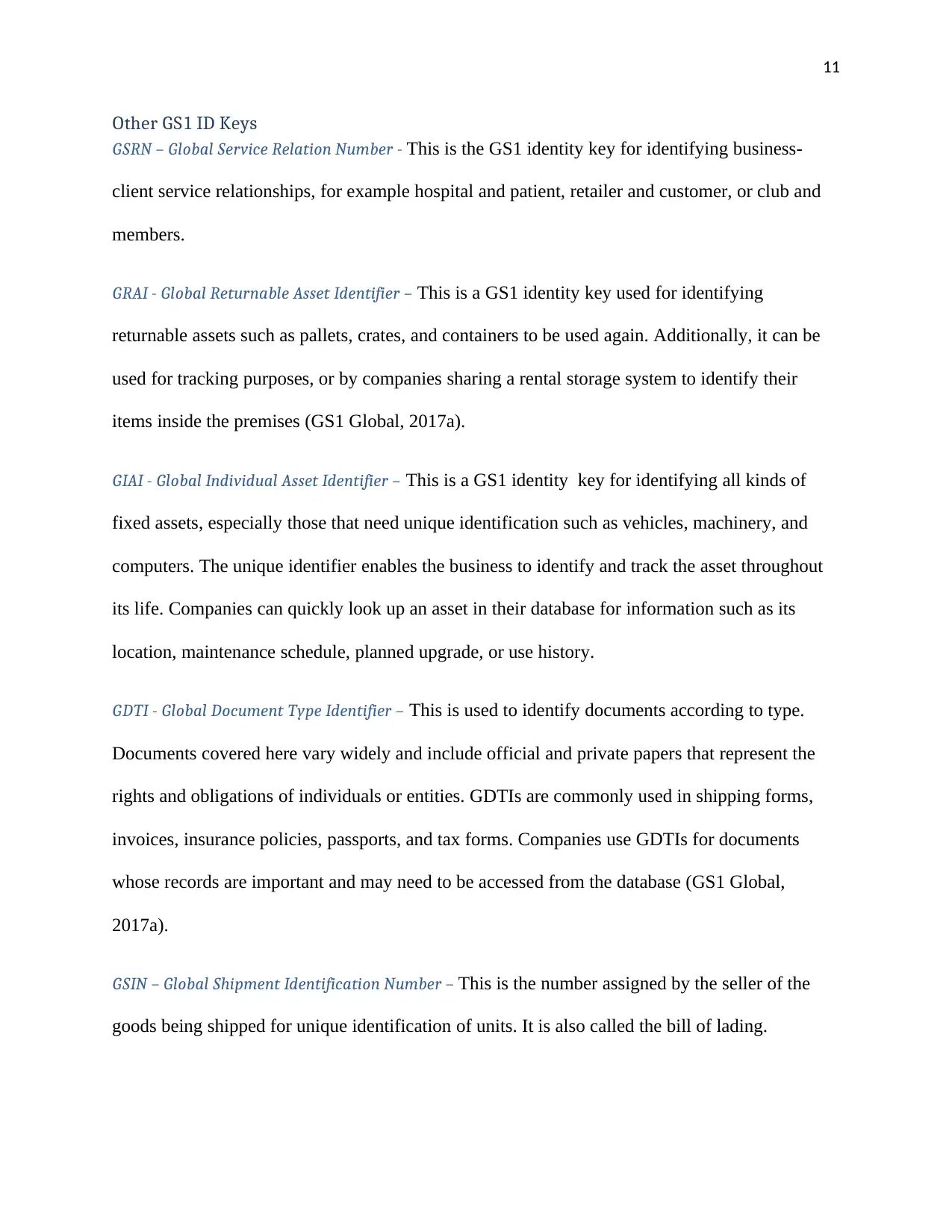
11
Other GS1 ID Keys
GSRN – Global Service Relation Number - This is the GS1 identity key for identifying business-
client service relationships, for example hospital and patient, retailer and customer, or club and
members.
GRAI - Global Returnable Asset Identifier – This is a GS1 identity key used for identifying
returnable assets such as pallets, crates, and containers to be used again. Additionally, it can be
used for tracking purposes, or by companies sharing a rental storage system to identify their
items inside the premises (GS1 Global, 2017a).
GIAI - Global Individual Asset Identifier – This is a GS1 identity key for identifying all kinds of
fixed assets, especially those that need unique identification such as vehicles, machinery, and
computers. The unique identifier enables the business to identify and track the asset throughout
its life. Companies can quickly look up an asset in their database for information such as its
location, maintenance schedule, planned upgrade, or use history.
GDTI - Global Document Type Identifier – This is used to identify documents according to type.
Documents covered here vary widely and include official and private papers that represent the
rights and obligations of individuals or entities. GDTIs are commonly used in shipping forms,
invoices, insurance policies, passports, and tax forms. Companies use GDTIs for documents
whose records are important and may need to be accessed from the database (GS1 Global,
2017a).
GSIN – Global Shipment Identification Number – This is the number assigned by the seller of the
goods being shipped for unique identification of units. It is also called the bill of lading.
Other GS1 ID Keys
GSRN – Global Service Relation Number - This is the GS1 identity key for identifying business-
client service relationships, for example hospital and patient, retailer and customer, or club and
members.
GRAI - Global Returnable Asset Identifier – This is a GS1 identity key used for identifying
returnable assets such as pallets, crates, and containers to be used again. Additionally, it can be
used for tracking purposes, or by companies sharing a rental storage system to identify their
items inside the premises (GS1 Global, 2017a).
GIAI - Global Individual Asset Identifier – This is a GS1 identity key for identifying all kinds of
fixed assets, especially those that need unique identification such as vehicles, machinery, and
computers. The unique identifier enables the business to identify and track the asset throughout
its life. Companies can quickly look up an asset in their database for information such as its
location, maintenance schedule, planned upgrade, or use history.
GDTI - Global Document Type Identifier – This is used to identify documents according to type.
Documents covered here vary widely and include official and private papers that represent the
rights and obligations of individuals or entities. GDTIs are commonly used in shipping forms,
invoices, insurance policies, passports, and tax forms. Companies use GDTIs for documents
whose records are important and may need to be accessed from the database (GS1 Global,
2017a).
GSIN – Global Shipment Identification Number – This is the number assigned by the seller of the
goods being shipped for unique identification of units. It is also called the bill of lading.
⊘ This is a preview!⊘
Do you want full access?
Subscribe today to unlock all pages.

Trusted by 1+ million students worldwide
1 out of 22
Related Documents
Your All-in-One AI-Powered Toolkit for Academic Success.
+13062052269
info@desklib.com
Available 24*7 on WhatsApp / Email
![[object Object]](/_next/static/media/star-bottom.7253800d.svg)
Unlock your academic potential
Copyright © 2020–2025 A2Z Services. All Rights Reserved. Developed and managed by ZUCOL.




